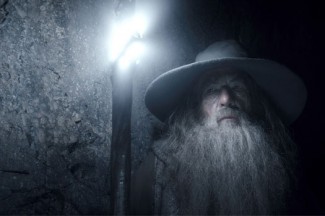
But however blissful this “magic” may be for the audience, unfortunately it appears to not extend behind the scenes, at least not in nearly the same capacity. Though some of Desolation of Smaug’s scenes may appear effortlessly woven together on screen, the fact is that the creation of these scenes does require a lot of work. Making it all come together can be taxing, not only on the visual effects artists, but also on the actors who sometimes have no physical set or even people to act off of, but instead only a green screen and an idea of what the scene will look like.
It is out of this necessity to act in the void, so to speak, that we get stories like the one that Sir Ian McKellen relayed in the special features on The Hobbit: An Unexpected Journey Extended Edition Blu-Ray set. McKellen shared his feelings about acting alone against a green screen:
“I got absolutely miserable and had a little cry to myself. I didn’t realize that the microphone I was wearing was open so everybody could hear me muttering to myself about how I wanted to go home and so on.
“It was so distressing and off-putting and difficult that I thought ‘I don’t want to make this film if this is what I’m going to have to do’. It’s not what I do for a living. I act with other people, I don’t act on my own.”
McKellen’s story got me thinking, particularly his last sentence or so about working with others rather than in a bubble. At first, it simply struck me as a commentary on the way that cinema is produced today, how even though we’re capable of doing the amazing things I discussed earlier, like creating vivid and exciting worlds and talking dragons, perhaps we’re doing it at the expense of the real. Perhaps in moving away from the puppetry, miniature models, and camera tricks of old, we’re losing some of the authenticity and connection with reality that comes from having to do things analog. As the use of CGI or computer-generated imagery becomes more and more dominant in films, perhaps the technology has begun to outshine the acting.
McKellen’s not the only seasoned actor to fall victim to this. Philip Seymour Hoffman’s stellar performance in Mission Impossible 3 was somewhat overshadowed by CGI. And even after his death, Hoffman will go head-to-head with visual effects in The Hunger Games, where he will be re-created by computer for his final scenes in the films.
As I reflected on the cinematic trends, I realized that even beyond the movies, McKellen’s words can apply to our lives in the modern era. How many of us live against our own “green screen,” interacting with others only through technology rather than face-to-face? With a wide variety of social media available to us, and the prevalence of iPods, tablets, smartphones, and the like, it has become remarkably easy to get lost in the wonders of technology and lose sight of the actual human contact that we can so simply replace with the click of a button.
Even though we can do amazing things with the technology we’ve got now, both in film and in our everyday lives, that doesn’t mean we should turn our backs on the value of human interaction. The way I see it, Sir Ian’s got it right — we all deserve to leave the tech behind and see the world that’s actually around us. Though there might not be dragons or wizards, interacting with other people can be a magic all its own.




